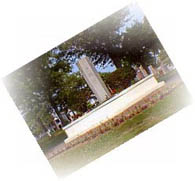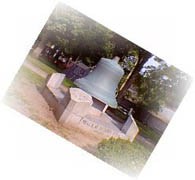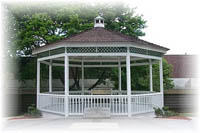The Derby Green(Now recognized as the Birmingham Green Historic District) Civil War MonumentThis monument was totally refurbished in 2019. Click here for the story. | ||
 |
|  |
DERBY GREEN HISTORYGreen Facelift 1999 - Click to see how they changed the Green! The site of the Derby Green, once known as the Derby Commons, hails back to 1836 when prominent local industrialist Sheldon Smith returned to his home town after making a fortune from commercial ventures in New York City. Smith bought land on the west bank of the Naugatuck River in order to create an industrial borough of the larger community of Derby. He first called his new town Smithville, but later changed the name to Birmingham. Smith then persuaded a business acquaintance from New York, Anson G. Phelps, to join him in founding this new industrial community. In 1836, the two businessmen asked the local selectmen to build a street through the property that already boasted 20 homes and three stores. Smith then hired British engineer and land agent John Cloues to lay out the streets of the downtown. Three principal thoroughfares radiating off Main Street were named for Smith’s daughters, Elizabeth, Minerva and Caroline, and a fourth was named after Phelps’ wife Olivia. The rectangle of land now known as the Derby Green was set aside at that time as a public common to be used by all residents of the thriving industrial community. Smith later donated land on the north and east sides of the public square for the Methodist and Episcopal churches. Phelps donated land to the west of the Green for the Second Congregational Church. The beauty of the Green was thus enhanced by the addition of three lovely churches to frame its perimeter. In a deed dated April 25, 1845, public ownership of the Green was formalized. The Commons was designated to remain forever a ‘Public Green" on the condition that the citizens of the town build a fence to keep sheep and residents off its grass. On October 4, 1852, a second document transferred ownership to the town for the sum of one dollar, forbidding any buildings to be placed on the land and restricting its use to military or public activities. A fourth monumental structure, the Sterling Opera House, was built at the close of the 19th century on the west side of the Green to house City Hall, a police station and a vaudeville house. The theater closed in the 1940s and City Hall moved in 1960 to nearby Fifth Street, but the Sterling still towers over the Green. Efforts are under way to restore it to its former glory as a working theater. For many years, a town pump on the southwest corner of the Green provided fresh water to residents who often lined up with jugs and pitchers to take home fresh spring water drawn from a 50-foot well below. In 1960, the well was deepened to 90 feet and the pump was replaced by a fountain that remains a favorite gathering place for thirsty children and neighborhood residents. Typical of most New England town greens, it is an island of serenity in the heart of town. The Derby Green has that special New England feeling as it is surrounded on three sides by churches, and a gazebo used for a variety of events, including a summer concert series and the annual Olde Derby Day, is at the end of the fourth side. Monuments to Derby's veterans of America's wars and local firemen are prominently displayed as a reminder of the City's contribution to the nation's history. Criss-crossed by walking paths, there are many park benches providing the opportunity to take a break from the bustle of modern life. The Green received a complete makeover in the spring of 1999. On April 21, 2000, the Birmingham Green Historic District was designated as Derby's sixth site on the National Register of Historic Places. Click here to see the others. | ||

